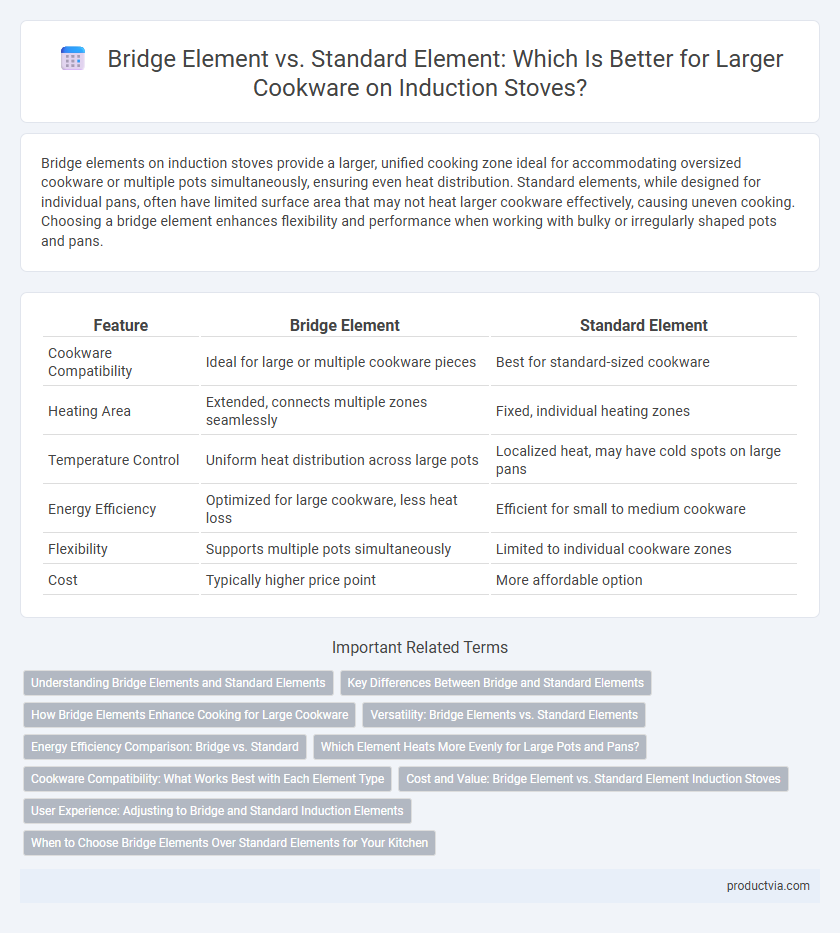Bridge elements on induction stoves provide a larger, unified cooking zone ideal for accommodating oversized cookware or multiple pots simultaneously, ensuring even heat distribution. Standard elements, while designed for individual pans, often have limited surface area that may not heat larger cookware effectively, causing uneven cooking. Choosing a bridge element enhances flexibility and performance when working with bulky or irregularly shaped pots and pans.
Table of Comparison
| Feature | Bridge Element | Standard Element |
|---|---|---|
| Cookware Compatibility | Ideal for large or multiple cookware pieces | Best for standard-sized cookware |
| Heating Area | Extended, connects multiple zones seamlessly | Fixed, individual heating zones |
| Temperature Control | Uniform heat distribution across large pots | Localized heat, may have cold spots on large pans |
| Energy Efficiency | Optimized for large cookware, less heat loss | Efficient for small to medium cookware |
| Flexibility | Supports multiple pots simultaneously | Limited to individual cookware zones |
| Cost | Typically higher price point | More affordable option |
Understanding Bridge Elements and Standard Elements
Bridge elements on induction stoves provide a larger, continuous cooking surface by connecting two or more standard elements, enabling efficient heating for oversized cookware such as griddles or large pots. Standard elements are individual cooking zones designed for typical cookware sizes, offering precise heat control but limited coverage for larger pans. Choosing a bridge element enhances versatility and uniform heat distribution when cooking with bulky or rectangular cookware, making it ideal for expansive meal preparation.
Key Differences Between Bridge and Standard Elements
Bridge elements on induction stoves allow users to combine two standard elements into a larger, continuous cooking zone ideal for oversized cookware or griddles, enhancing heat distribution and flexibility. Standard elements are fixed in size and operate independently, limiting the surface area to accommodate only smaller pots or pans. The key difference lies in the ability of bridge elements to seamlessly adjust to the size and shape of larger cookware for more efficient and uniform heating.
How Bridge Elements Enhance Cooking for Large Cookware
Bridge elements on induction stoves create a seamless, larger cooking surface ideal for accommodating oversized cookware such as griddles and large pots. These elements distribute heat evenly across the extended area, eliminating hot spots and ensuring consistent cooking performance. By connecting two standard elements, bridge technology increases flexibility and efficiency, making it easier to cook multiple items simultaneously or handle bulky pans.
Versatility: Bridge Elements vs. Standard Elements
Bridge elements on induction stoves offer enhanced versatility by seamlessly connecting two cooking zones, accommodating larger or irregularly shaped cookware with even heat distribution. Standard elements are limited to fixed sizes, making them less adaptable to oversized pots or griddles. Choosing bridge elements maximizes cooking flexibility and efficiency when handling bulky cookware.
Energy Efficiency Comparison: Bridge vs. Standard
Bridge elements on induction stoves offer superior energy efficiency for larger cookware by seamlessly combining two or more heating zones into one, ensuring even heat distribution and minimal energy loss. Standard elements, while effective for smaller pots, often result in uneven heating and higher energy consumption when used with oversized pans due to limited surface coverage. This optimized design of bridge elements reduces energy waste and enhances cooking performance for large cookware compared to standard single-zone elements.
Which Element Heats More Evenly for Large Pots and Pans?
Bridge elements on induction stoves provide more even heating for large pots and pans by seamlessly connecting two separate cooking zones into a single, larger surface area. Standard elements, while efficient for smaller cookware, often cause uneven heat distribution when used with oversized pots due to limited induction zones. The enhanced surface coverage and uniform magnetic field of bridge elements minimize hot spots, ensuring consistent temperature across the entire cookware base.
Cookware Compatibility: What Works Best with Each Element Type
Bridge elements on induction stoves offer enhanced compatibility with larger, rectangular, or multiple cookware pieces by allowing seamless heat distribution across extended surfaces. Standard induction elements are optimized for round, single pots and pans, providing focused heating but limited coverage for oversized cookware. For versatile cookware compatibility, bridge elements better accommodate larger or irregularly shaped vessels, ensuring consistent cooking performance.
Cost and Value: Bridge Element vs. Standard Element Induction Stoves
Bridge elements on induction stoves offer significant value for larger cookware by creating a unified cooking surface that accommodates oversized pots and pans efficiently. While bridge elements typically come at a higher upfront cost compared to standard elements, their enhanced versatility reduces the need for multiple burners and improves cooking performance for large meals, delivering long-term savings and convenience. Standard elements, being more affordable initially, may lack the capacity for large cookware, potentially limiting usability and increasing overall cooking time.
User Experience: Adjusting to Bridge and Standard Induction Elements
Bridge elements on induction stoves offer seamless heating across larger cookware, providing even heat distribution and eliminating hot spots compared to standard elements with fixed zones. Users experience greater flexibility with Bridge elements, enabling effortless adjustment to differently sized pots and pans without repositioning. Standard elements may require precise alignment of cookware to maximize efficiency, which can impact user convenience and cooking performance.
When to Choose Bridge Elements Over Standard Elements for Your Kitchen
Bridge elements on induction stoves offer a seamless cooking surface ideal for larger cookware, providing even heat distribution across griddles and oversized pots. Standard elements may create hot spots and limit flexibility when using multiple pans or oddly shaped cookware. Choose bridge elements to maximize cooking efficiency and accommodate expansive cookware setups in professional or large-home kitchens.
Bridge element vs Standard element for larger cookware Infographic

 productvia.com
productvia.com